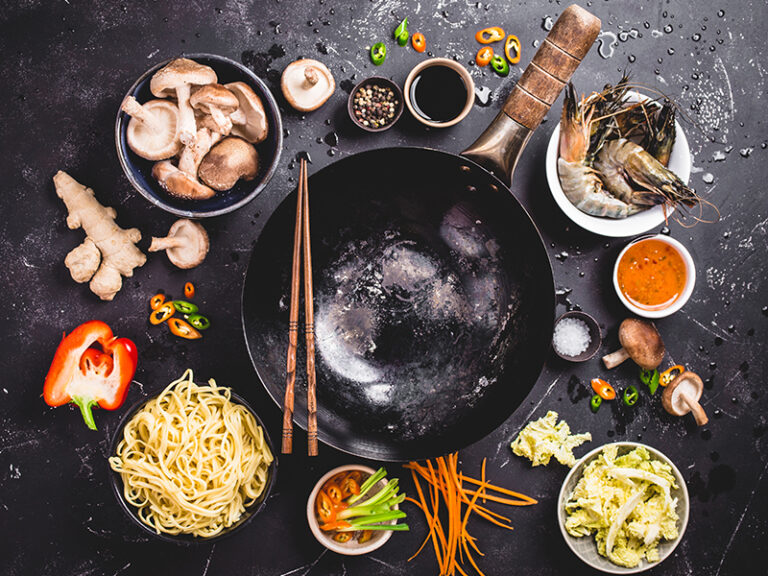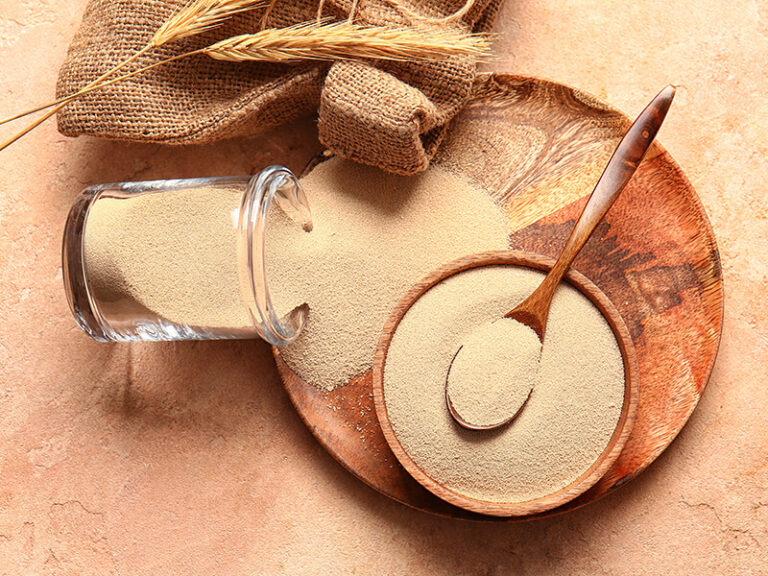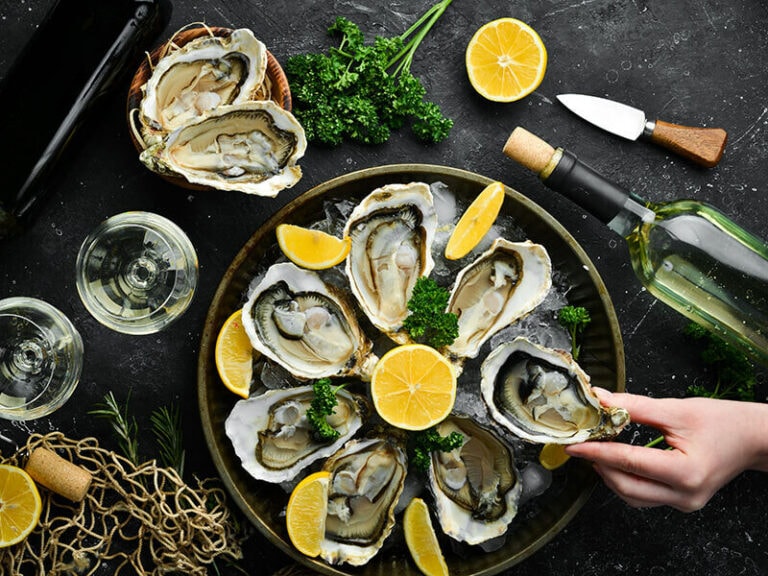Not all people can thoroughly answer the question “what do nuts taste like” because you know how vast the variations are. Not one or two species, but there are a dozen types of nuts. However, I’m here to handle the job. Follow along to find out the flavors of all your favorite nuts.
After all, nuts serve multiple purposes in the culinary world. They can be great snacking, flavorings, or key ingredients in your savory dishes and drink. You will have to use them at some points, so it’s better to know their taste to be fully prepared.
There is no need to do a taste test for all common nuts on your own because I have got you fully covered. Read on and learn about the taste of different nuts, storage methods, and when to discard the spoiled ones. What are you waiting for? Let’s crack some nuts!
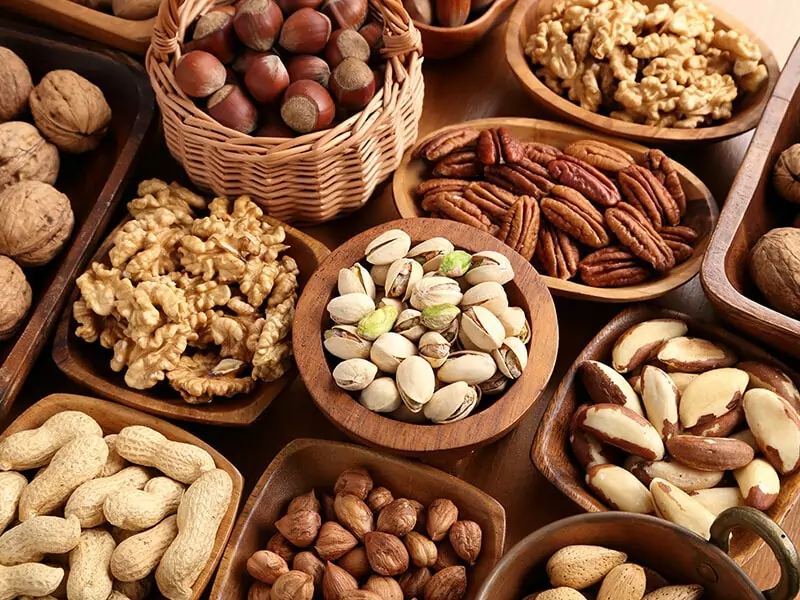
Seeds, Fruits, Or Legumes? – Find Out The Nuts’ Identity
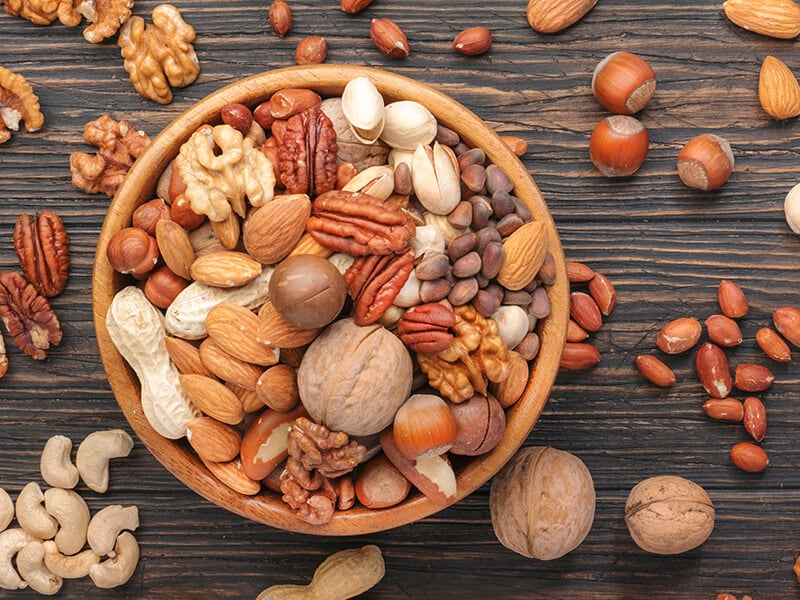
According to the FDA, nuts are fruits(1). Botanically speaking, nuts appear as a single-seeded edible inside a hard or leathery shell and contain high oil content. Simpler speaking, they are hard-coated seeds that usually grow alone.
Still, if you look closer, some common “nuts” don’t meet this botanical definition. Almonds, for example, are not nuts but drupes in the botanical sense. That goes for the same case as pine nuts, cashews, and pistachios. Similarly, peanuts share the same fates since they are legumes.
The question here is: Why are these drupes, seeds, and legumes still classified as nuts? In the culinary sense, it’s a yes to all of them. From a gastronomical standpoint, the term nuts are less restrictive. The culinary definition of nuts is any dry and edible thing underneath a shell.
Depending on botany or culinary terms, you’re welcome to define the identity of your favorite nuts. However, whether they are “true” nuts, I’m sure you can’t help devouring this goodness.
Strengthen your knowledge about nuts with this fun and simple explanation now!
What Do Nuts Taste Like?
In the culinary sense, nuts are a broad term with many variations. Each type has its own nuttiness, tastes, and notes. Therefore, it’s hard to give the same answer to all. Let’s go into detail to find out more!
An Overall Taste
Sweetness, bitterness, and nuttiness – nuts can be them all. Generally speaking, nuts are nutty and on the savory side, in essence. In rare cases, a few may tend to a sweeter term, and some are bitter and sour. They can still be salty, but the saltiness comes from additives.
Since nuts are the same term for many species and varieties, their taste won’t be the same. It’s important to know what they taste like to mix and match them for different culinary purposes. Some nuts are more suitable in savory recipes, while others work best in sweet treats.
Of all the nuts, pecans are indeed the sweetest. At the same time, cashews and pistachio have a more nutty flavor than others. Additionally, chestnuts are sour, whereas walnuts are bitter.
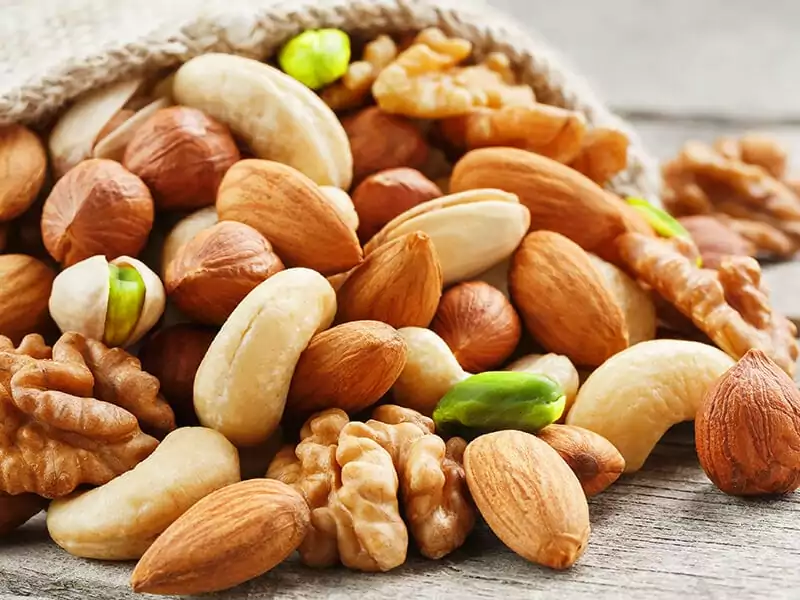
Tastes Of Some Familiar Culinary Nuts
From baking and snacking to cooking, nuts play multiple roles in the culinary world. But that doesn’t mean you can use them interchangeably in any recipe. Understanding their flavor will help you determine which nuts to use in certain dishes.
1. Macadamias
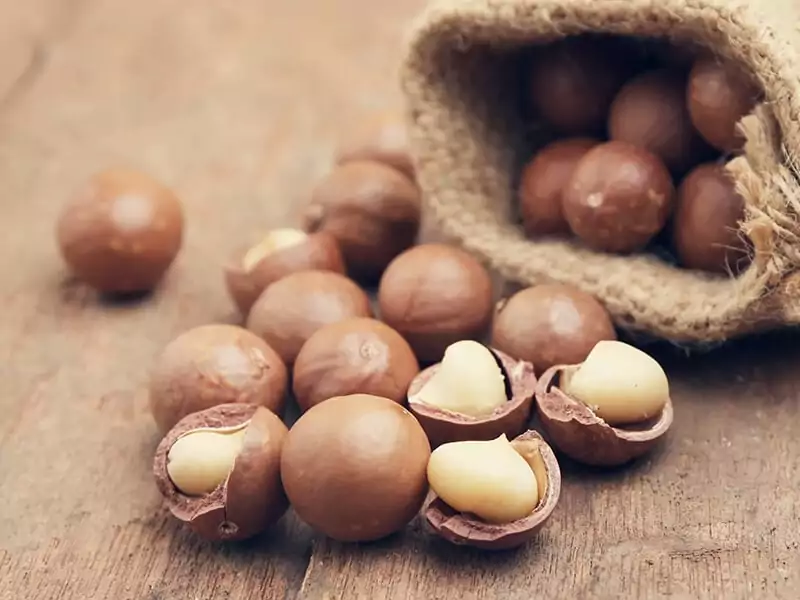
Interestingly, though macadamias (Macadamia spp.) has deep roots in Australia, its largest producer is in South Africa. But you will be more surprised that they are the most expensive among the nuts due to their notoriously hard shells.
You’ll never see macadamia sold in the shell because it’s the hardest nut to crack. The serious effort to take the edible out of the shell adds more numbers to the bill. Another reason for its high price is that a macadamia tree will take seven to ten years to produce.
In return, their buttery and rich flavor are worth an investment. Eating raw macadamias is acceptable. However, roasting will take their taste to the next level since it will concentrate the nut’s sweetness and buttery flavor.
Whether it’s salads, smoothies, or baked goods, macadamias shine in both sweet and savory applications. Noticeably, given their tropical roots, they also make a great pair with coconut, coffee, and citrus. Be bold and try these pairings if possible.
A 100g serving of raw macadamias provide:
- Mono-unsaturated fat: 58.877 g
- Fibre: 8.6 g
- Calcium: 85 mg
- Potassium: 368 mg
If you still can’t understand why the price of macadamia nuts is sky-rocket, figure it out here.
2. Pistachios
Unlike macadamias, pistachios (Pistacia vera) are always sold in shells. Though these nuts haven’t been a household name yet, using this ingredient in recipes is a growing trend in the industry.
A member of the cashew family, these nuts love to grow in hot and dry countries, specifically the Central Asia region, where they are a popular ingredient in desserts and puddings. Their mild flavor with a hint of sweetness is a great addition to these countries’ culinary cultures.
As a stand-alone snack, pistachios carry a little bit of saltiness due to their additives. On their own, these green-and-purple gems are flawless ingredients. Flavored or not, they’re terrific in sweet and savory menus, such as ice creams, cakes, full-flavored salad, or lamb koftas.
Even better, pistachios are marketed as guilt-free snacks with many nutritional benefits. This nut is a phytosterol powerhouse that supports heart disease. Also, consuming pistachios benefits your eyes since they are the only nut containing lutein and zeaxanthin.
A 100g serving of raw pistachios provide:
- Phytosterols: 271.9 mg/ per 100g oil
- Potassium: 1,025 mg
- Zeaxanthin + Lutein: 1405 μg
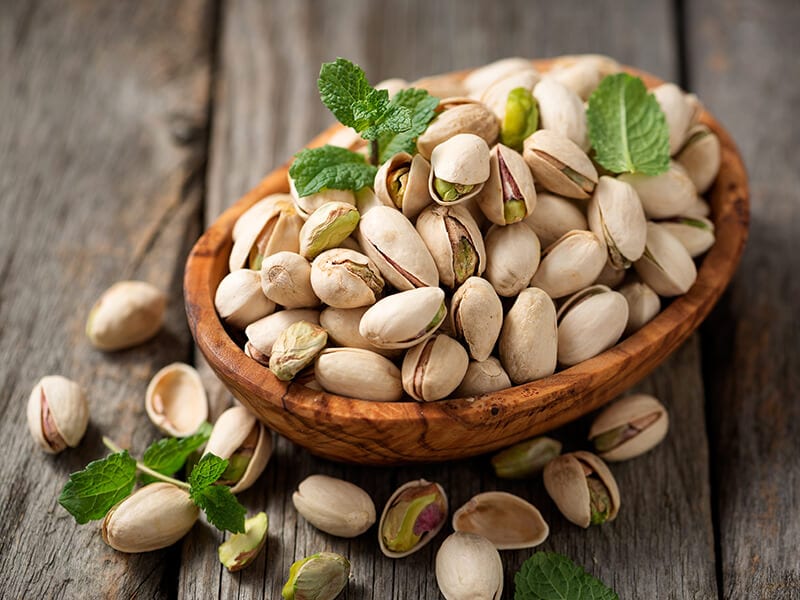
3. Peanuts
Botanically, this item is not actually a “nut”, but a legume, like the case of peas and beans. But that doesn’t stop them from becoming the most-consumed nuts in the world. Native to South America, peanuts (Arachis hypogaea) have probably been with humans for 10000 years(2).
They come in full shells on the market as these babies are easy to crack open. Raw, steamed, roasted, or flavored – peanuts taste fantastic in any form. Their raw flavor is earthy and savory. Thus, manufacturers often add salt or sweetener when selling them as snacks.
Culinary speaking, peanuts are more favorable in sweet dishes. You may frequently come across peanut ice cream, candies, or peanut butter. Still, in the tropics, the presence of peanuts adds a new touch to savory recipes, including Indonesian satay sauce or West African soups.
A 100g serving of raw peanuts provide:
- Protein: 25.8 g
- Fiber: 8.5 g
- Fat: 49.24 g
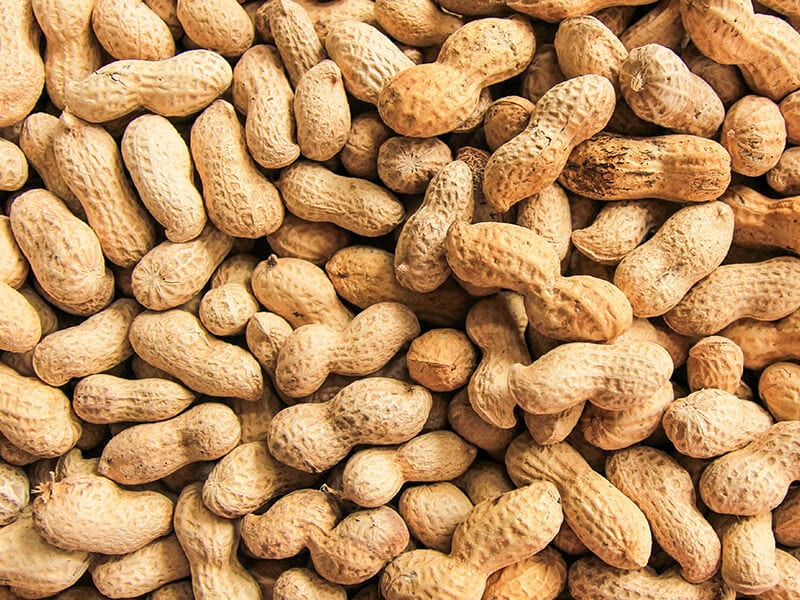
4. Pecans
Verified as a “Heart-Healthy Food” by the AHA, pecans (Carya illinoinensis) are ideal snacks to devour every day(3). This beneficial nut comes from the US and Mexico. More specifically, Georgia, New Mexico, and Texas are home to most US pecan plantations.
Taste-wise, pecans are oily and rich in fats, giving them a pleasantly buttery and sweet flavor, but that is a different story with the bitter outer. Though eating raw pecans will maximize health benefits, the explosion of mushy taste before the sweetness hits won’t be easy for your palate.
Instead, after baking or roasting, they will be more friendly to people’s taste buds and perfect for pie making. The dry heat will enhance the nuts’ overall flavor. Apart from pie, their sweet taste, creaminess, and crunchy texture also shine in other desserts.
A 100g serving of raw pecans provide:
- Plant sterols: 95 mg
- Antioxidants: 17,940 ORAC units
- Oleic acid: 49% – 76.5% of the Daily Value (DV)
- Mono-unsaturated fat: 40.801 g
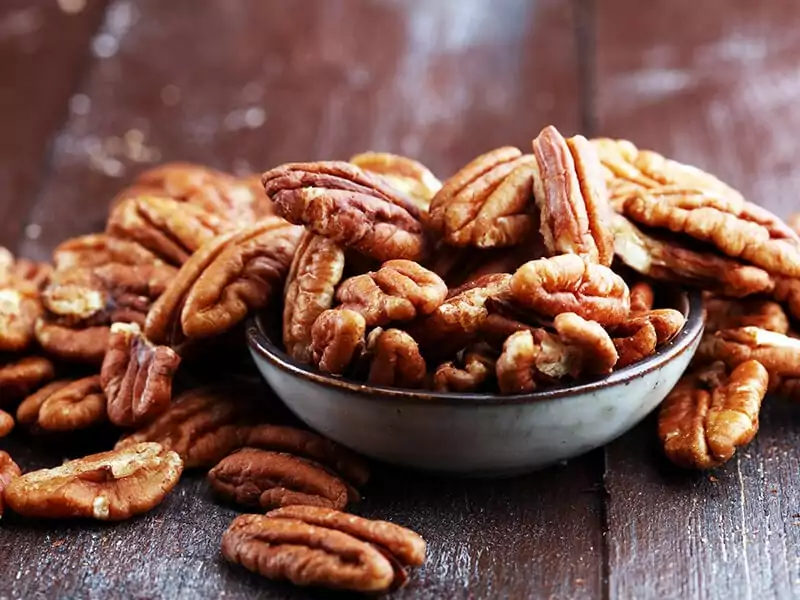
5. Almonds
This nut has gone a long way from its motherland Iran to be available in other parts of the world. Botanically speaking, almonds, or Prunus dulcis, don’t fit the definition of true nuts. They are technically seeds with a leathery coat.
Almonds stand out due to their unique flavors, as determined by the tree variety. Simply put, these nuts come in three different kinds: sweet, semi-bitter, and bitter. Yet, while the sweet type is for sale commercially, the bitter ones reach consumers with their by-products.
Choose carefully because raw consumption of wild and bitter almonds is unpleasant in both taste and texture. It’s worth mentioning that leaving the skin on brings greater benefits. Despite its bitterness, almond skin is rich in flavonoids with great antioxidant benefits.
As an ingredient, almonds and sweet dishes are a powder duo. Almond paste, almond extract, or marzipan – you name it. And what about snacks? Almonds go along well with everything in any added flavorings, from sweet and salty to spicy.
A 100g serving of raw almonds provide:
- Calcium: 248 mg
- Monounsaturated fat: 32.155 g
- Fibre: 11.8g
- Vitamin E: 25.63 mg
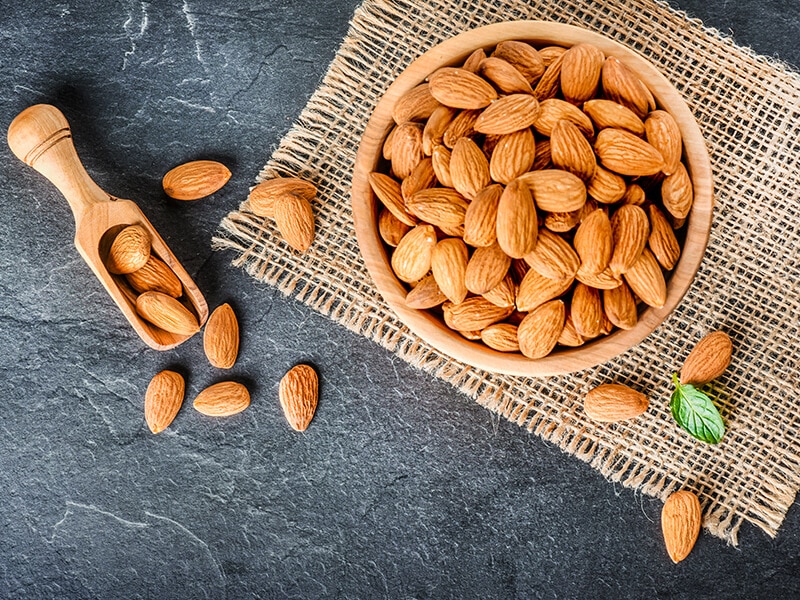
6. Brazil Nuts
As its name implies, you may realize this nut is closely associated with Brazil and South America. Unlike other commercially cultivated plants in this list, Brazil nuts (Bertholletia excelsa) live in specific places. They grow in the wild, harvested in rainforests of the Amazon.
Like almonds, these natural gems are seeds rather than nuts. With a smooth buttery texture and delectable nutty taste, they are versatile in many dishes, from sweet to savory. Raw consumption is acceptable, but roasting and seasoning will add more depth to their flavors.
From a nutrition standpoint, these nuts are a rich source of vitamin E and selenium, an antioxidant supporting immunity and aiding wound healing. Only one to three Brazil nuts a day is enough for the daily requirement of selenium, and vitamin E.
A 100g serving of raw Brazil nuts provide:
- Vitamin E: 7.87 g
- Selenium: 1917 µg
Are you curious about the production of Brazil nuts? Satisfy your curiosity here.
7. Cashews
Cashews, or Anacardium occidentale, are out of botanical definition for “nuts”. In fact, they are seeds of tropical evergreen shrubs in northeastern Brazil and the tropics. Penned as a superfood, cashews are full of magnesium, a crucial substance for improving human memory.
Spoiler alert: the raw cashews on the market aren’t actually unprocessed. They have been under high heat to remove the shell and toxins. As such, roasted cashews will go through the heated process twice: one for shelling and one for deepening flavors as well as colors.
Roasted and “raw” cashews are commonly used, but do you know that their powdered form is present in some Indian sweets and desserts as well? Also, powdered cashew can be an excellent flour replacement in multiple recipes.
From savory meals to sweet recipes, this tropic-rooted nut can rock them all with its neutral, savory flavors and crunchy texture. It would be a shame if I forgot to mention cashews’ role in dairy-alternative production. The list goes on with cashew butter, milk, sour cream, and more.
A 100g serving of raw cashews provide:
- Mono-unsaturated fats: 23.797g
- Iron: 6.68 mg
- Zinc: 6 mg
- Magnesium: 292 mg
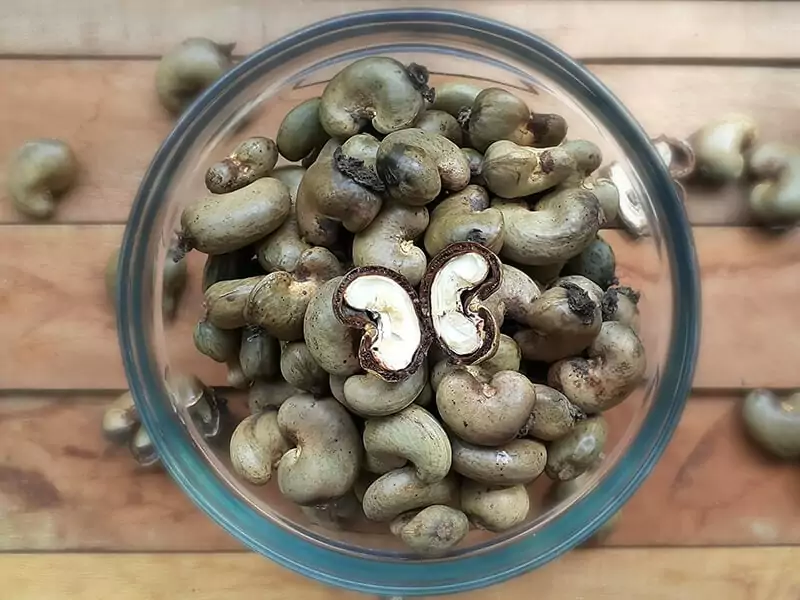
8. Chestnuts
Native to Northern temperate zones, chestnuts (Castanea spp.) are special when they fit in both the culinary and botanical sense. As an aquatic tuber, this plant is considered a tree nut. Commercial growers cultivate chestnuts in China, Turkey, and South Korea.
Nobody eats raw chestnuts because of their bitterness. Thus, you have to cook them for the best taste. Baked or oven-roasted chestnuts get high praise for their sweet, nutty, and buttery flavor. Some even compare them to the taste of cooked sweet potato.
Roasted chestnuts can go to great lengths in recipes since their mild taste lets other elements shine. In addition, they are also a healthy snack when your craving strikes. You may even find this goodness roasted at street vendors when the winter holidays arrive.
The best part is this nut has the lowest fat and calorie content, so feel free to mix and match it into your daily diet. Buy it in bulk if you want, but note that this species is more perishable than other siblings. Refrigerating chestnuts is the best option to maintain their quality.
A 100g serving of raw chestnuts provide:
- Calorie: 213 kcal
- Fat: 2.26 g
- Fibre: 5.5 g
- Vitamin C: 43 mg
- Carbohydrates: 45.54 g
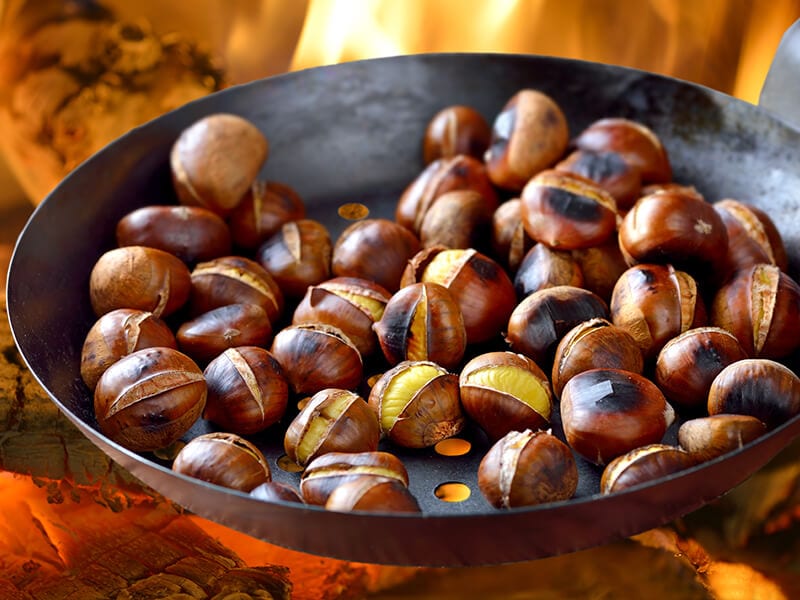
9. Pine Nuts
Though pine nuts (Castanea sativa) are not in the spotlight like other siblings, they hold a firm standing in the culinary world. Botanically, pine nuts are not real “nuts”. Coming from the Northern Hemisphere, they are seeds derived from different species of pine cones.
The prices of pine nuts may shock you. Still, it’s reasonable since manufactures have to spend extra labor costs to get things done. Workers have to climb to the pine cones and pick them by hands. Plus, a pine tree has to reach an age of 25 to be mature enough to get harvested.
The nuttiness, earthiness, and subbed sweetness are what foodies love about pine nuts. A friendly warning: they won’t be an ideal snack in the raw form since uncooked nuts are too soft. To get the most out of these nuts, toast them up, and their tastes will be out of this world.
On a related note, the roasted nuts also perform well with savory recipes. Their crunchiness is beyond perfect in pasta, salads, or crostini. Plus, pine nuts are also high in oil, making them the key ingredient for pesto. Its natural oil gives the sauce a savory flavor and creaminess.
A 100g serving of raw pine nuts provide:
- Vitamin E: 9,33 mg
- Omega-3 fatty acids: 112 mg
- Magnesium: 71 mg
After hearing this detailed explanation, you won’t ever complain about pine nuts’ price again.
10. Coconuts
Commonly known as stone fruit, coconuts may cause wonders why they made it on this list, but they are indeed nuts. Precisely, this specie is a tree nut under FAD’s designation(4). Coconuts are widely cultivated in the tropics: the Philippines and Indonesia are top producers.
These giant nuts are hard on the outside and chewy on the inside, featuring solid shells and soft white flesh. Unique textures come with special flavors, so it’s no shock that this nut’s pulp is sweet, creamy, and juicy. Its white meat is delicate enough to be in multiple recipes.
While this goodness does great in candies and desserts, it also adds a tropical hint to meat and fish dishes. Its creaminess is the highlight in gravy-consistency meals like curries. Not to mention, coconuts are a key ingredient in oh-so-delectable products like milk, cream, or water.
High in healthy fats and essential minerals, the giant nut deserves to be on your daily meal. Given the affordable price and multiple usages, it’s no wonder coconuts have one of the most significant productions of any nuts.
A 100g serving of raw coconuts provide:
- Protein: 3 g
- Manganese: 65% of the DV
- Selenium: 18% of the DV
- Copper: 48% of the DV
- Iron: 14% of the DV
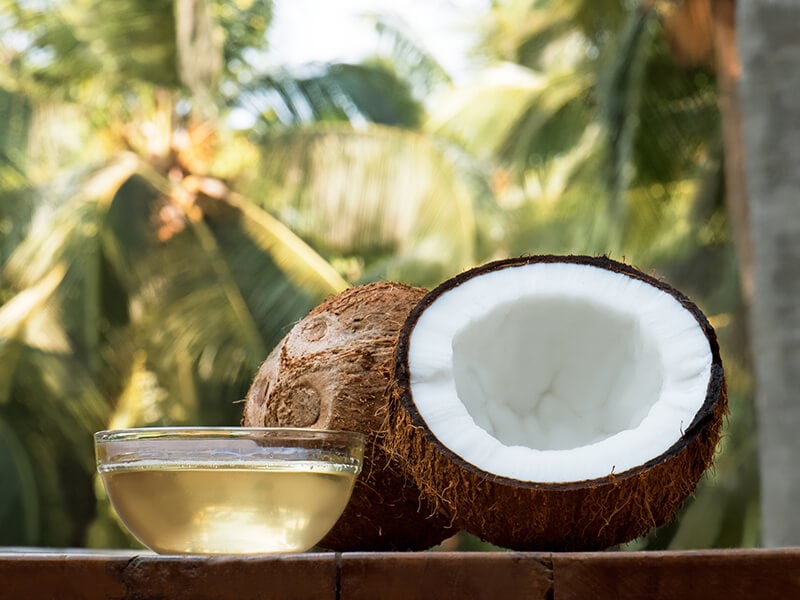
11. Walnuts
Indigenous to Iran and Central Asia, walnuts, or Juglans regia, appear in countless recipes. Roasted or chopped up, these babies shine in both sweet and savory dishes, from salads and cookies to brownies. If you have a sweet tooth, give the walnut candy a try.
Due to the high tannin content in the flesh, they are famous for their sharp and bitter notes. Be careful because this unpleasant mouthfeel may become an addiction. A handful of these nut pieces can go a long way, and their tannic quality will add a pleasing dimension to your dishes.
On the market, the shelled walnuts are preferable to the unshelled ones because it’s hard to break open these outers. One thing to note is that the walnut kernels will spoil faster than the intact ones, so think carefully before purchasing them.
In addition, this item has a high oil content, which is good for culinary uses, but the opposite for storage. If you don’t store them with high precautions, these gems will become rancid sooner than expected.
A 100g serving of raw walnuts provide:
- Omega-3 fatty acids: 9,079 mg
- Antioxidant: 20 mmol
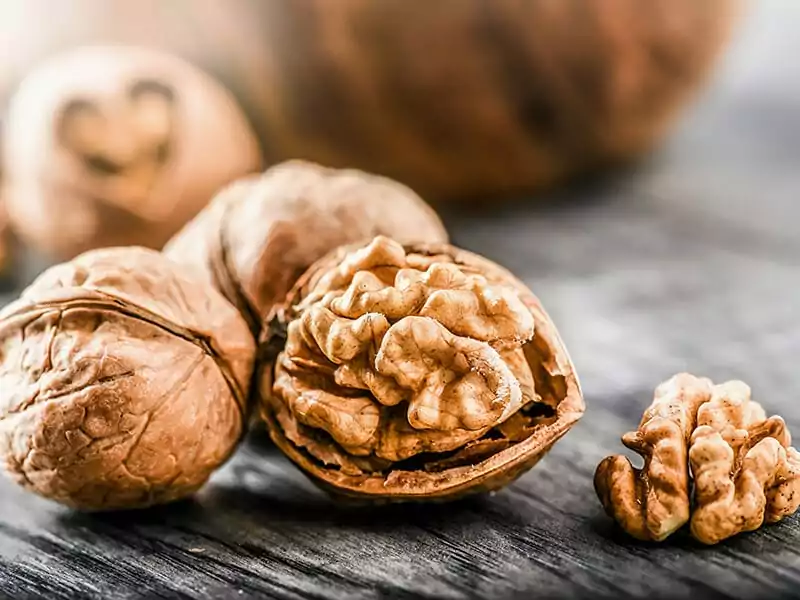
12. Hazelnuts
Hazelnuts, or Corylus avellana, originate from the temperate Northern Hemisphere regions. These babies are perhaps best known for being the main ingredient in Nutella.
Their earthiness and sweetness are matches made in heaven with chocolate, but these nuts are more than that. They perform well in various foods, from baked goods and candies to salads. Don’t forget that hazelnuts are excellent snacks too!
You will be interested to know that hazelnut white flesh and brown skin are edible in raw form. Still, not many people eat them uncooked because the musty taste before the sweetness hits may be unbearable.
Instead, roasting or toasting hazelnuts will deepen their flavors, making them friendly to people’s taste buds. Consuming the nuts with the skin on is advisable. However, sellers often remove the bitter skin since it may affect the naturally nutty taste of hazelnut.
A 100g serving of raw hazelnuts provide:
- Mono-unsaturated fat: 45.652 g
- Vitamin E: 16 mg
After listening to what a health expert explains about hazelnuts, you will want to buy them immediately.
Nuts Are Good For You – True Or Not?
Most of the nuts, given in a botanical or culinary sense, are nutrient-dense. They are a powerhouse of magnesium, vitamins, fibers, and plant proteins.(5) More importantly, they give the body healthy fats/oils (omega-3s) without adding too many calories to your diet.
Therefore, eating more nuts is good for your body’s weight since these nutrient packages will keep you full longer and can help reduce the amount of food you eat. At the same time, nuts also contribute to preventing some health conditions, such as heart disease.
Nuts are healthy snacks for kids and adults alike. As with everything else, consuming these treats in a rational quantity per day will bring spectacular benefits to your health.
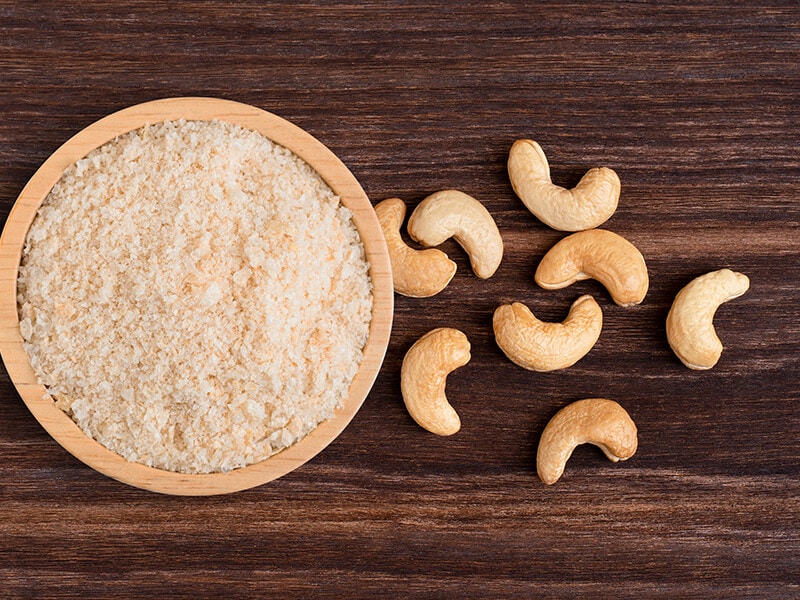
Guidelines To Store Your Nuts Properly
Nuts last longer than most fruits and vegetables, but they’ll go rancid over time. Unsaturated fats are the leading cause of this deterioration because rancidity happens due to fat oxidation. However, under correct storage, you can slow down the rancidity rates.
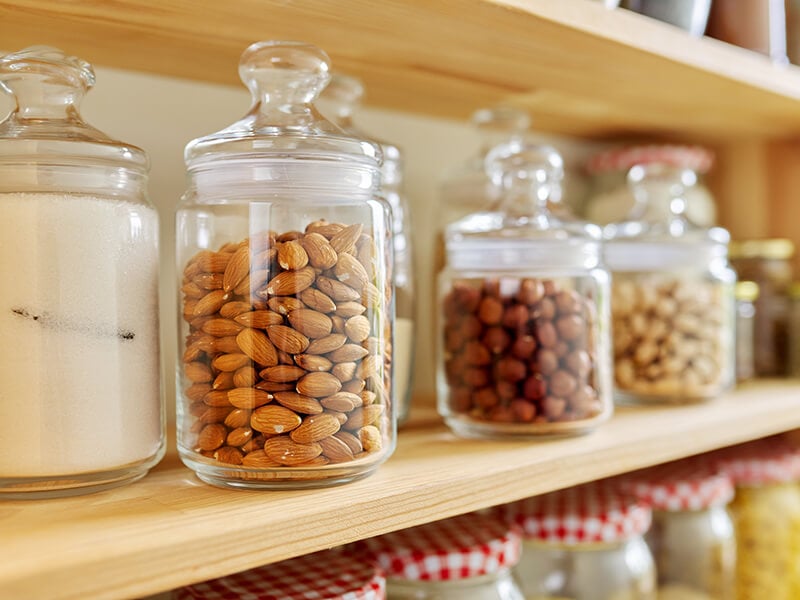
Remember To Keep It Airtight
Whether you leave the nuts in the pantry or the fridge, always remember to reduce their oxygen exposure. Sealing your precious gems tightly in airtight containers or bags is a must.
At Room Temperature
At room temperature, leave them in a cool, dry, and dark place. Doing so will protect them from external threats like light, oxygen, and heat. Your favorite snack treats can stay fresh for about three to six months on the pantry or kitchen counter.
What’s About Cold Storage?
Refrigerating will slow the oxidative rate and maintain your nut’s quality for about a year. However, placing them in the freezer is the best option to maximize the nut’s shelf life. Frozen nuts are edible within two years.
If your nuts keep going rancid quickly, regardless of what you do, learn the proper ways to store them here!
Signs To Throw Your Rancid Nuts Away
Though minor consumption of rotten nuts doesn’t reach a fatal point, avoiding eating them is better for your body. Moreover, these spoiled nuts can destroy your entire baking batch with their sour and bitter taste. Check the signs below to have in-time action with the spoiled nuts.
Smell
The most apparent hint of rotten nuts is their smell. Give them a whiff, and it’s a clear sign of spoilage if you sense an unpleasant odor. The smell of rotten nuts resembles oil paint, nail polish remover, and even plastic containers.
Texture
Another exterior indicator is the texture. For most nuts, if you recognize them becoming softer and losing their crunchiness, there is a high chance that they have gone bad.
Taste
When nothing is wrong with smell and texture, but you’re still uncertain about the nut’s quality, it’s time to give them a shot. Take a small piece and do a taste test. If it’s rancid, it will taste nastily sour and bitter.
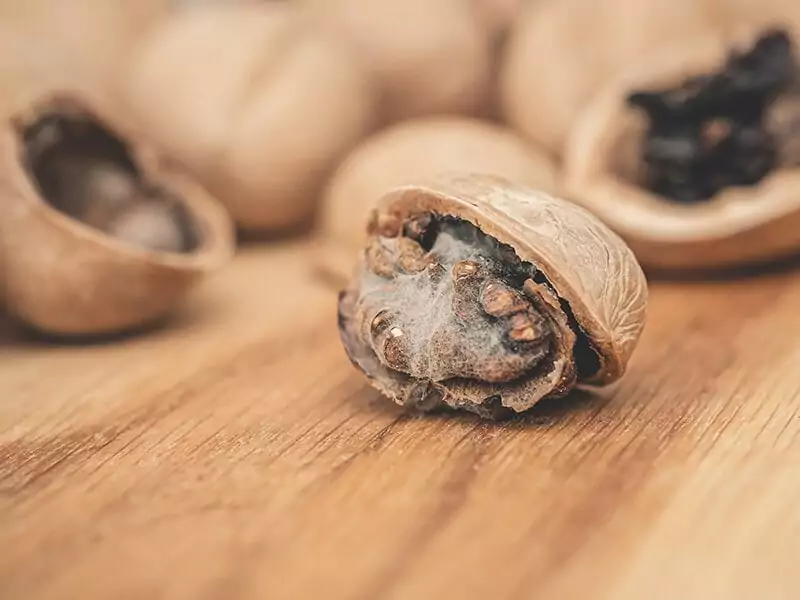
FAQs
I hope you have got the desired answer for what nuts taste like. If you’re eager to learn more about the nuts, here are some additional questions I thought you might have.
Let’s Get Cracking On The World Of Nuts!
The deeper you dive into the world of nuts, the more exciting things you will find out. Now you know all of the secrets behind the curtain. Be creative and experiment with them in plenty of dishes.
Instead of snacking on unhealthy junk foods, switching to these healthy babies are better. But be mindful that even though nuts are nutritious, taking them in large concentrations at once is risky. Have a moderate intake of nuts daily so you won’t put your health at risk.
What is your favorite nut? Comment to let me know. Please remember that your feedbacks and sharings are valuable for this website’s thriving and my content updates. Don’t be shy to repeat those actions since they are my motivations to make better articles for you. Until next time!
References
- U.S. Forest Service (no date) Forest Service Shield.
- Decoding the peanut (no date) AgResearch Mag.
- American pecans certified with American Heart Association’s “Heart-check mark” (2021) West Coast Nut.
- Affairs, O.of R. (no date) Section 201(QQ) of the ACT defines the term “major food allergen” to include “tree nuts.” in addition to the three examples provided in Section 201(QQ) (almonds, pecans, and walnuts), what nuts are considered “tree nuts?”, U.S. Food and Drug Administration. FDA.
- Mead, L.C. et al. (2021) The effect of nut consumption on diet quality, cardiometabolic and gastrointestinal health in children: A systematic review of randomized controlled trials, International journal of environmental research and public health. U.S. National Library of Medicine.

